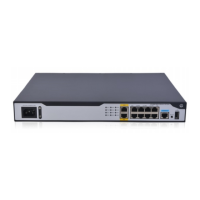241
server. The users can access the resources provided by the website. If the users want to access the
Internet, they must pass authentication on the website.
Portal authentication is classified into the following types:
Active authentication—Users visit the authentication website provided by the portal Web
server and enter their username and password for authentication.
Forced authentication—Users visit other websites and are redirected to the portal
authentication website for authentication.
Portal authentication flexibly imposes access control on the access layer and vital data entries. It has
the following advantages:
Replaces client software with convenient authentication pages.
Provides ISPs with diversified management choices and extended functions. For example, the
ISPs can place advertisements, provide community services, and publish information on the
authentication page.
Supports multiple authentication modes. For example, re-DHCP authentication implements a
flexible address assigning scheme and saves public IP addresses. Cross-subnet authentication
can authenticate users reside in subnets different from the access device.
The device support portal 2.0 and portal 3.0.
Command reference
See HPE FlexNetwork MSR Command References(V7).
New feature: MSDP
Configuring MSDP
MSDP is an inter-domain multicast solution that addresses the interconnection of PIM-SM domains.
It discovers multicast source information in other PIM-SM domains.
In the basic PIM-SM mode, a multicast source registers only with the RP in the local PIM-SM domain,
and the multicast source information in each domain is isolated. As a result, both of the following
occur:
The RP obtains the source information only within the local domain.
A multicast distribution tree is built only within the local domain to deliver multicast data locally.
MSDP enables the RPs of different PIM-SM domains to share their multicast source information. The
local RP can then join the SPT rooted at the multicast source across the PIM-SM domains. This
allows multicast data to be transmitted among different domains.

